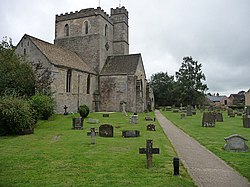Leonard Stanley
| Leonard Stanley | |
| Gloucestershire | |
|---|---|
 St Swithuns church | |
| Location | |
| Grid reference: | SO804037 |
| Location: | 51°43’48"N, 2°17’9"W |
| Data | |
| Population: | 1,466 (2011) |
| Post town: | Stonehouse |
| Postcode: | GL10 |
| Dialling code: | 01453 |
| Local Government | |
| Parliamentary constituency: |
South Gloucestershire |
Leonard Stanley is a village in Gloucestershire to the south of the town of Stonehouse. It is fund about three miles west of Stroud and seven miles east of the River Severn.
This is a place of just 600 homes nestling beneath the Cotswold escarpment, overlooking the Severn Vale. The surrounding land use around Leonard Stanley is primarily agricultural.
Originally a Saxon village, Leonard Stanley became a busy weaving and agricultural centre, with shops and cottage industries, until the 1970s. In recent years the village profile has changed to that of a commuter village, with families mostly commuting to the surrounding towns and cities. The community however still has a heart and this website celebrates the wealth of rural life that still exists, and the people who play a part in it. Leonard Stanley is situated seven miles from the city of Gloucester and thirty miles from Bristol. It is easily accessible by road with Junction 13 of the M5 motorway just three miles away.
Parish church
The parish church of St Swithun dates from the 12th century and is a Grade I listed building.[1]
History
What once had been described as a market town, "Leonard Stanley with its fairs and its weekly market, for some time the only one in the hundred, was formerly a centre of trade; it was described as a market-town in 1650. It declined in importance after the 17th century, and the beginning of the decline was later associated with the fire of 1686." This later declined.[2]
John Wesley visited on his missionary travels:
"It was with difficulty we made our way through this most loving people, and returned amidst their prayers and blessings to Ebly. Here I expounded the second lesson for two hours, and received strength and faith to plead the promise of the Father. A good old Baptist pressed me to preach at Stanley, in my way to Bristol."[3]
In 1870-72, John Marius Wilson's Imperial Gazetteer of England and Wales described Leonard Stanley.
LEONARD-STANLEY, or STANLEY-ST. LEONARDS, a village and a parish in Stroud district, Gloucester. The village stands 1 mile E by S of Frocester r. station, 1½ S by E of Stonehouse r. station, and 3½ SW by W of Stroud; was once a market-town; was nearly all destroyed by fire in 1686; and has a post office under Stonehouse, and a fair on 20 July. The parish contains also the hamlet of Downton, and includes the detached tract of Lorridge. Acres, 1,070. Real property, £4,188; of which £655 are in railways.[4]
About the village
A nature reserve, Five Acre Grove, lies close to the village and is designated a 'Key Wildlife Site'.
Outside links
| ("Wikimedia Commons" has material about Leonard Stanley) |
- Leonard Stanley Parish Council
- Leonard Stanley on Stroud Voices
References
- ↑ National Heritage List 1171487: Church of St Swithin
- ↑ A History of the County of Gloucester - Volume 10 pp 257-259: {{{2}}} (Victoria County History)
- ↑ Charles Wesley, The Journal of the Rev. Charles Wesley (London: Hutchinson & Co., 1849)
- ↑ GB Historical GIS / University of Portsmouth, History of Leonard Stanley, in Stroud and Gloucestershire | Map and description, A Vision of Britain through Time.
- Nikolaus Pevsner: Pevsner Architectural Guides